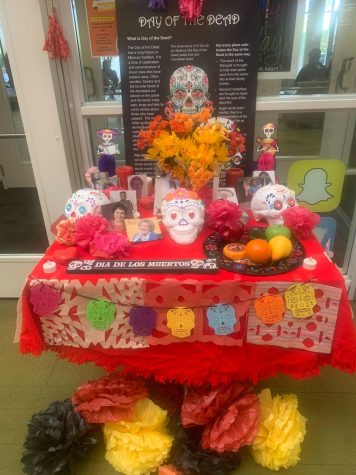The Reunion of the Living with the Dead (English)
Each year on the Day of the Dead, many Latinx people celebrate the lives of their loved ones who have passed on.
November 7, 2022
Hopefully, the sun will shine on the sugar skulls and the photographs, together around the papel picado (decorative tissue paper with cut-out shapes) of all colors on the altars. Unfortunately, sometimes, it has rained. Depending on the country, when it has been very cold outside, it has snowed. Those days, it’s possible that some families that wanted to celebrate next to the tombstones in the cemeteries would have moved their celebrations indoors. But many of them stay in their original places. For others that celebrate at home or in their church, only their mood is affected. However, in any case, the people that celebrate the Day of the Dead each year won’t stop soon.

Altars like this, and many that are similar or different, are some of the most important parts of the Day of the Dead. They can honor anyone who has passed away and has family members who want to celebrate their loved ones and their lives. For the special occasion, living members of the family prepare the favorite foods and drinks of the deceased person to show that they appreciate, remember and even invite them to visit.
Elizabeth Mares, a Spanish professor at COD who has spoken Spanish for over 30 years, spoke about the beauty in the traditions of Día de los Muertos.
“Día de los Muertos traces its roots to the Aztecs,” said Mares. “The Aztecs used skulls to honor the dead. They used to place the skulls on their temples to remember and honor them.”
Today, sugar skulls are a common symbol of the Day of the Dead. Other things such as specific flowers, foods and songs are used to honor and celebrate lost loved ones.

“On Nov. 1 and 2, we believe that the souls of the dead come back to visit us and celebrate their life with us,” Mares explained. “We light the way with candles, their souls fly through our papel picado, they see the paths to their altars with bright orange marigold flowers that we call Cempasúchil, the Aztec marigold. The souls that come back to visit us smell their favorite foods, they hear their favorite songs and they feel the love of their families as they sit together by their ofrendas.”
The Day of the Dead is not like a funeral in the United States. It is true that the Day of the Dead helps with grief for the family, but all in all, it is a holiday, a celebration, a time of happiness. Mares recounted a past visit to the National Museum of Mexican Art in the Pilsen neighborhood of Chicago with some COD students.
“There was an altar dedicated to children in Mexico that died in a bus crash. It hit my students and me so hard,” Mares said. “I tried to feel their laughter while imagining them playing with their toys to honor their happy moments in life, but it was so hard because they were so young and innocent. That is the beauty of learning about others’ lives and stories, you innately develop a sense of compassion and empathy for your fellow humans sharing this journey of life with you.”
While the Day of the Dead is mainly celebrated in Latinx countries, anyone in any place can honor their deceased loved ones with this annual celebration. Also, since the Day of the Dead lasts two days instead of one, you have even more time to celebrate with your family, both living and in the spirit world.
More information about the Day of the Dead as a celebration in the United States can be found here.


















